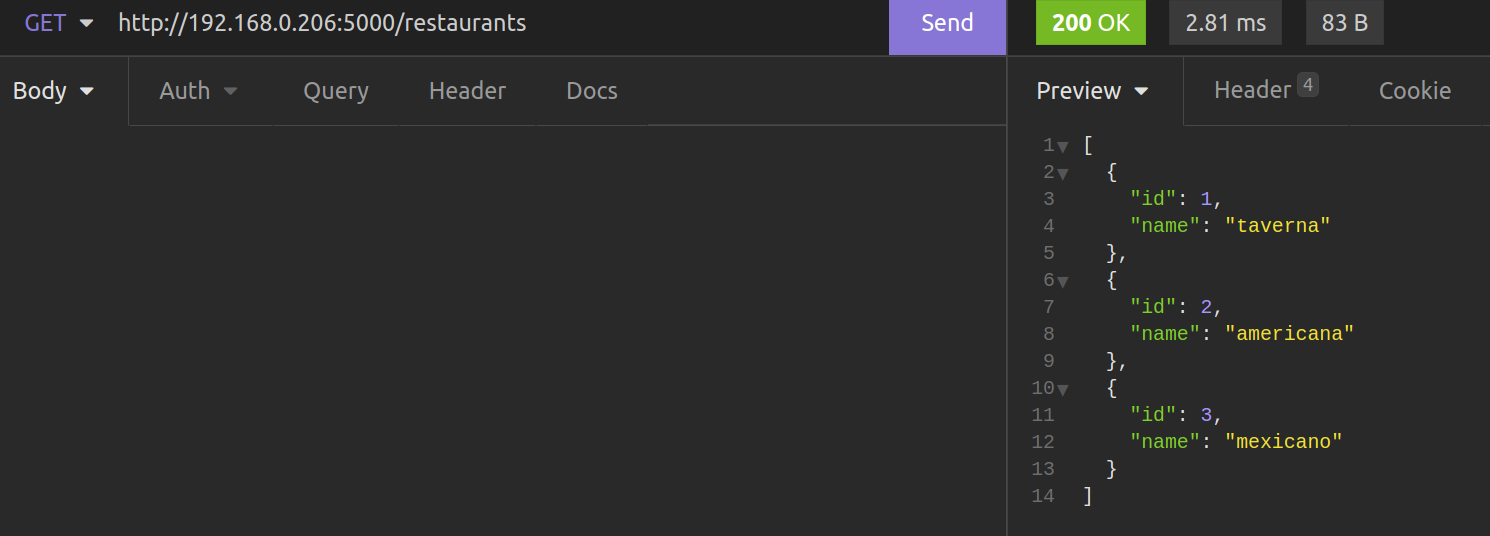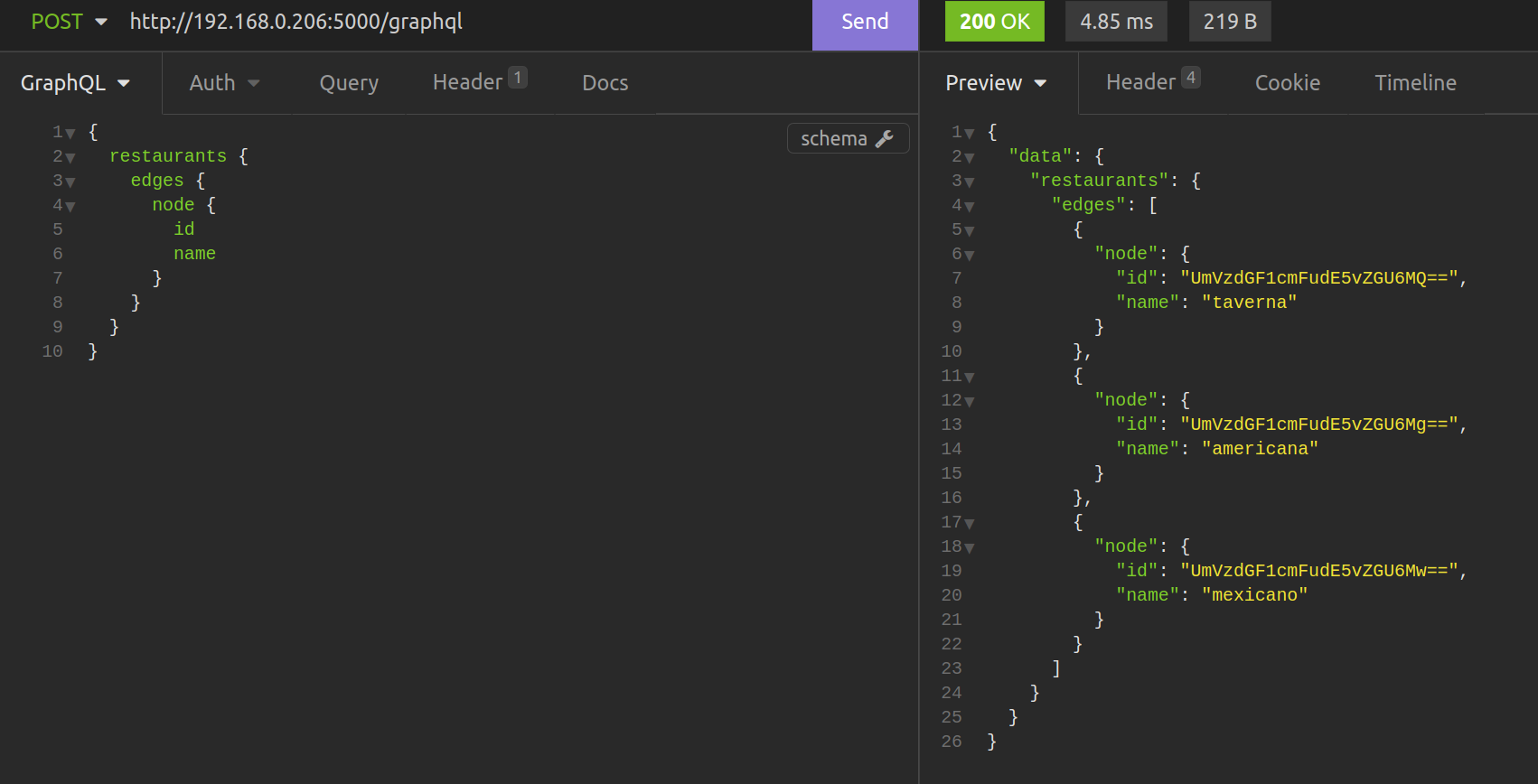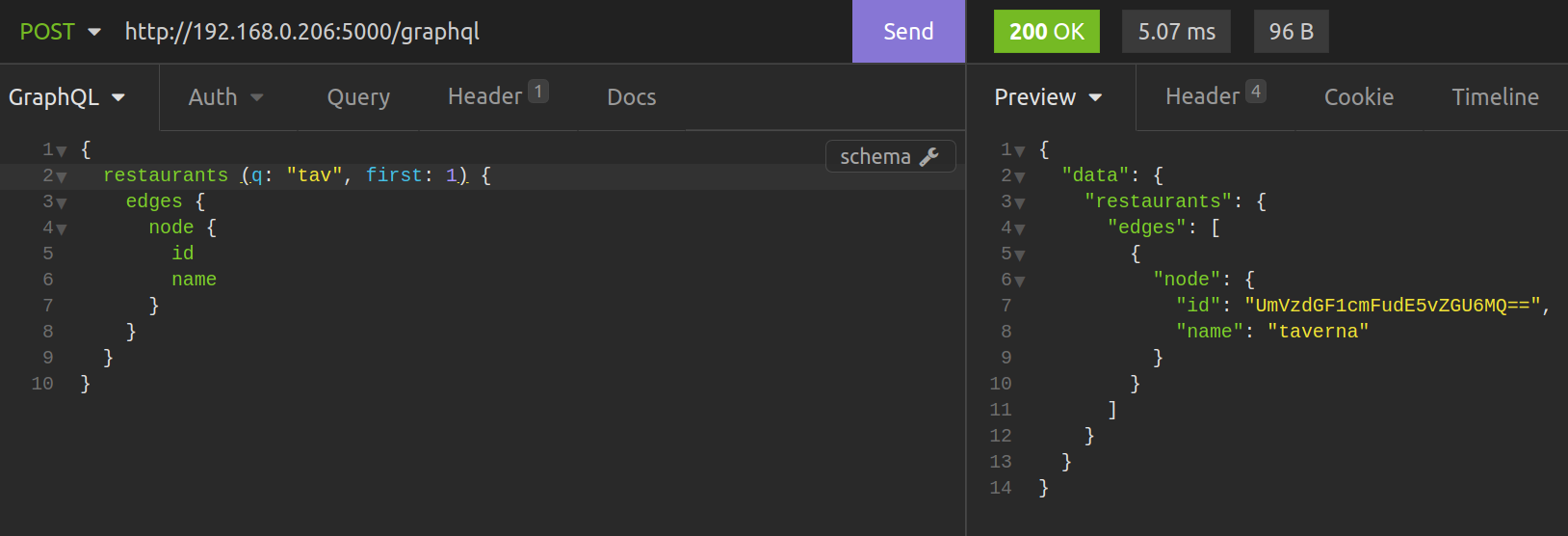GraphQL API and REST API. Mirror implementations in Python
[rest graphql python Introduction
REST is probably the most popular way to expose your application to the external world (e.g. as a backend for the frontend or to establish communication protocol with other applications/services). However, GraphQL is now getting more and more popular and has become a strong competitor for REST. Nevertheless, the aim of this post is not to carry out a detailed comparison of the advantages/disadvantages of these approaches, because there is a lot of stuff covering that topic. I would rather like to present how REST and GraphQL differ in implementation strategies. This post can be especially helpful for people who are familiar with the REST pattern and wonder how to broaden their interests in GraphQL technology.
Application requirements
First of all, I create a simple flask project with Blueprint functionality to provide REST API. In contrast to REST, which needs a separated HTTP endpoint for each business action, GraphQL exposes only one HTTP endpoint both for queries and commands. There is a flask_graphql package that exposes this endpoint with request syntax parsing provided. To build GraphQL schema I use the graphene library and sqlalchemy to build simple ORM models. To present the results of both APIs I use insomnia which is a powerful REST HTTP client with GraphQL integration.
pip install flask
pip install flask_graphql
pip install graphene<3
pip install sqlalchemy
Simple query
We start from a simple health check feature that ensures us that our application setup is valid and both REST API and GraphQL API are exposed to the world. For REST we define a simple HTTP endpoint within the blueprint.
# api/rest.py
from flask import Blueprint, jsonify
main = Blueprint("main", __name__)
@main.route("/")
@main.route("/up")
def up():
return jsonify({"up": True})
Here is a query result for the GET request in insomnia:

GraphQL is a strongly typed query language, so we must define Schema with root object Query that defines possible entry points into the GraphQL API. For each field of the schema, we define a resolver function that determines the returned value (it usually uses a database connection/session to determine what value should be returned).
# api/graphql.py
import graphene
class Query(graphene.ObjectType):
up = graphene.Boolean()
def resolve_up(root, info, **kwargs):
return True
schema = graphene.Schema(query=Query)
Both queries and commands in GraphQL are executed as POST requests. So in insomnia, we choose the POST request structured as GraphQL Query.

Query real objects
We have our “hello world” working, so now we can turn to real objects queries. To do it, we define a simple data model of Restaurant using SQLAlchemy ORM.
# models.py
from sqlalchemy import Column, Integer, String
from db import Base
class Restaurant(Base):
__tablename__ = "restaurant"
id = Column(Integer, primary_key=True, autoincrement=True)
name = Column(String)
To query all Restaurant instances in REST we add a new HTTP endpoint and recruitment_serializer to transform our model into JSON-like format.
from flask import Blueprint, current_app, jsonify
from models import Restaurant
main = Blueprint("main", __name__)
def restaurant_serializer(restaurant: Restaurant) -> Dict[str, Any]:
return {"id": restaurant.id, "name": restaurant.name}
@main.route("/restaurants", methods=["GET"])
def restaurants():
session = current_app.session
restaurants = [restaurant_serializer(r) for r in session.query(Restaurant)]
return jsonify(restaurants)
In insomnia, we execute a GET request at /restaurants URL:

For GraphQL we need to define the RestaurantNode schema object. RestaurantConnection is an additional object that provides some useful features for working on collections (like results limiting, pagination, etc.).
# api/graphql.py
import graphene
from models import Restaurant
class RestaurantNode(graphene.ObjectType):
class Meta:
interfaces = (graphene.relay.Node,)
name = graphene.String()
class RestaurantConnection(graphene.Connection):
class Meta:
node = RestaurantNode
class Query(graphene.ObjectType):
up = graphene.Boolean()
restaurants = graphene.relay.ConnectionField(RestaurantConnection)
def resolve_up(root, info, **kwargs):
return True
def resolve_restaurants(root, info, **kwargs):
session = info.context["session"]
return [RestaurantNode(id=r.id, name=r.name) for r in session.query(Restaurant)]
schema = graphene.Schema(
query=Query, types=[RestaurantNode]
)
To query the list of restaurants we execute a POST request and determine which fields we would like to get (we still have the up field in our schema, but it is not necessary for us now, so we don’t query it) using the same /graphql endpoint:

Command
We have seen how to query objects using both REST and GraphQL. In the following section, I would like to present how to modify data. To make it happen, the domain model was enriched by adding Table, TableBooking, and User entities.
# models.py
from datetime import datetime
from typing import Optional
from sqlalchemy import Boolean, Column, DateTime, ForeignKey, Integer, String
from sqlalchemy.orm import relationship
from db import Base
class NoOpenTable(Exception):
pass
class User(Base):
__tablename__ = "user"
id = Column(Integer, primary_key=True, autoincrement=True)
email = Column(String, unique=True)
table_bookings = relationship("TableBooking")
class Table(Base):
__tablename__ = "table"
id = Column(Integer, primary_key=True, autoincrement=True)
max_persons = Column(Integer, nullable=False, default=2)
is_open = Column(Boolean, default=True, nullable=False)
restaurant_id = Column(ForeignKey("restaurant.id"))
restaurant = relationship("Restaurant")
def book(self):
self.is_open = False
class Restaurant(Base):
__tablename__ = "restaurant"
id = Column(Integer, primary_key=True, autoincrement=True)
name = Column(String)
tables = relationship("Table", lazy="dynamic")
def book_table(self, persons: int, user: User):
table = self._get_open_table(persons)
if not table:
raise NoOpenTable()
table.book()
return TableBooking(user=user, restaurant=self, persons=persons)
def _get_open_table(self, persons) -> Optional[Table]:
return self.tables.filter(
Table.is_open.is_(True), Table.max_persons >= persons
).first()
class TableBooking(Base):
__tablename__ = "table_booking"
id = Column(Integer, primary_key=True, autoincrement=True)
booked_at = Column(DateTime, default=datetime.utcnow)
user_id = Column(ForeignKey("user.id"), nullable=False)
user = relationship("User")
restaurant_id = Column(ForeignKey("restaurant.id"), nullable=False)
restaurant = relationship("Restaurant")
persons = Column(Integer, nullable=False, default=1)
Our command that modifies the state of the domain model, will be booking a Table in given Restaurant by User identified by email. Both REST and GraphQL are clients for the same application logic, so we abstract it into a service layer function book_restaurant_table that is responsible for the whole business action:
from sqlalchemy.orm import Session
from models import Restaurant, TableBooking, User
def book_restaurant_table(
session: Session, restaurant_id: int, user_email: str, persons: int
) -> TableBooking:
user = session.query(User).filter_by(email=user_email).first()
restaurant = session.query(Restaurant).get(restaurant_id)
table_booking = restaurant.book_table(persons, user)
session.add(table_booking)
session.commit()
return table_booking
REST to modify resources use POST, PUT or DELETE verbs. To add a new TableBooking instance as a result of the booking action, we implement a new HTTP POST endpoint that handles the request and executes the book_restaurant_table use case:
from flask import Blueprint, current_app, jsonify, request
from service import book_restaurant_table
main = Blueprint("main", __name__)
@main.route("/bookings", methods=["POST"])
def bookings():
session = current_app.session
payload = request.get_json()
_ = book_restaurant_table(
session,
restaurant_id=payload["restaurant_id"],
user_email=payload["user_email"],
persons=payload["persons"],
)
return jsonify({"isBooked": True}), 201
Performing a request POST in insomnia with input data results in a response with a 201 status code:

In GraphQL mutation, an object must be defined to carry out an operation that results in side effects (change of state). We define BookRestaurantTable and also declare it in the GraphQL schema:
import graphene
from graphene.relay.node import from_global_id
from service import book_restaurant_table
class BookRestaurantTable(graphene.Mutation):
class Arguments:
restaurant_gid = graphene.ID(required=True)
persons = graphene.Int(required=True)
user_email = graphene.String(required=True)
is_booked = graphene.Boolean()
def mutate(self, info, restaurant_gid: str, persons: int, user_email: str):
session = info.context["session"]
_, restaurant_id = from_global_id(restaurant_gid)
_ = book_restaurant_table(session, restaurant_id, user_email, persons)
return BookRestaurantTable(is_booked=True)
class Mutation(graphene.ObjectType):
book_restaurant_table = BookRestaurantTable.Field()
schema = graphene.Schema(
query=Query, mutation=Mutation, types=[UserNode, RestaurantNode]
)
To execute a mutation we use the same insomnia setup, but the body of the GraphQL request is a little bit different from query one. We use mutation key-word and pass camel case name of mutation declared here: book_restaurant_table = BookRestaurantTable.Field(). The response returns the result payload with the 200 status code:

Parameterized queries
We showed a simple query that fetches all Restaurant instances. However, we usually want to parameterize queries by passing arguments, limiting results, making searches, etc. Like for mutation application logic can be agnostic of the API that consumes it, so we can implement it in the service layer as the get_restaurants function:
from typing import Optional
from sqlalchemy.orm import Query, Session
from models import Restaurant
def get_restaurants(
session: Session, search: Optional[str] = None, limit: Optional[int] = None
) -> Query:
filter_args = []
if search:
filter_args.append(Restaurant.name.ilike(f"%{search}%"))
query = session.query(Restaurant).filter(*filter_args)
if limit:
query = query.limit(limit)
return query
As far as REST API implementation is concerned, we can take parameters from the request.args structure.
@main.route("/restaurants", methods=["GET"])
def restaurants():
session = current_app.session
query = get_restaurants(
session,
search=request.args.get("q"),
limit=request.args.get("limit")
)
restaurants = [restaurant_serializer(r) for r in query]
return jsonify(restaurants)
To execute the request in insomnia, we use the GET method and pass parameters in url query string:
 To parameterize GraphQL connection (list of instances), we must define allowed input arguments. We don’t have to define limit parameter because
To parameterize GraphQL connection (list of instances), we must define allowed input arguments. We don’t have to define limit parameter because relay.Connection class that we use has built-in first, last, before, and after arguments.
class Query(graphene.ObjectType):
up = graphene.Boolean()
restaurants = graphene.relay.ConnectionField(
RestaurantConnection, q=graphene.String()
)
def resolve_up(root, info, **kwargs):
return True
def resolve_restaurants(root, info, **kwargs):
query = get_restaurants(
info.context["session"],
search=kwargs.get("q"),
limit=kwargs.get("first")
)
return [RestaurantNode(id=r.id, name=r.name) for r in query]
schema = graphene.Schema(query=Query)
Here you can see how to pass these arguments in GraphQL schema execution:

Autogenerated schema
We don’t have to define GraphQL schema and REST serialization functions / classes from scratch. For GraphQL we can use graphene-sqlalchemy library, while in REST marshmallow-sqlalchemy library to build schema upon SQLAlchemy ORM models. It can give a head start and fast iteration but has also a huge drawback. You share the domain model in the public contract (with application clients, like the frontend app). So you must consider all pros and cons and whether it is worth doing.
Summary
In this post I showed you how you can start with GraphQL when you are familiar with REST (or in opposite direction). However, I understand that this post does not cover an important part of application building, like authentication or authorization. This can be material for another text.
Here is a full project implementation: https://github.com/jorzel/service-layer/ because in code listings some parts were omitted for better readability.
Thanks!